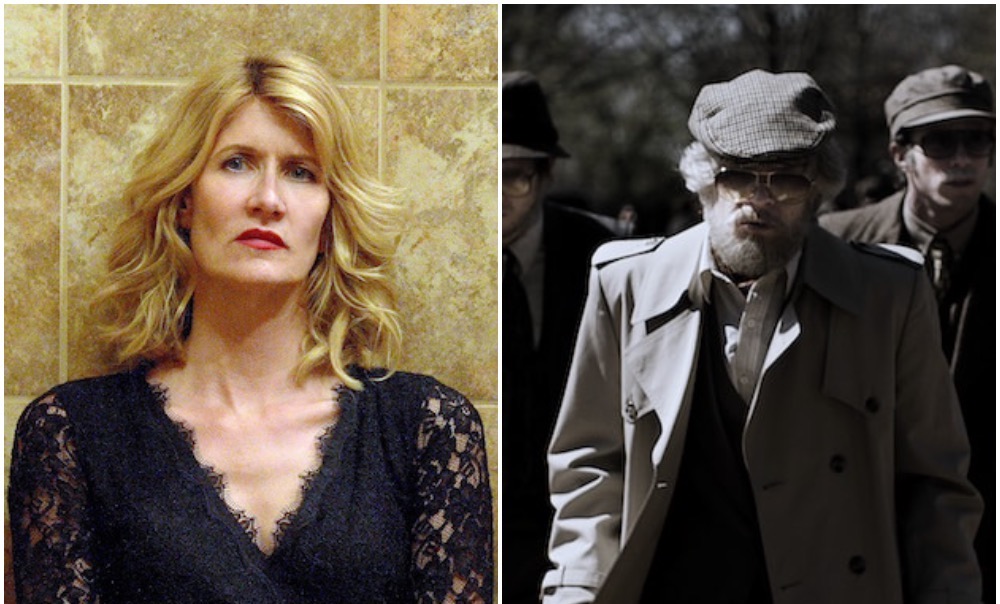“We tell ourselves stories in order to survive,” says Laura Dern in voiceover in “The Tale,” the new narrative feature from documentarian Jennifer Fox (now streaming on HBO Go). The film is a hybrid of fiction and actuality: Dern is playing Fox, who was inspired to make the film when, at age 48, she slowly realized that she had been lying to herself for decades about the true, predatory nature of her relationship with her high school running and riding coaches.
“The Tale” made waves when it premiered at the Sundance Film Festival back in January because of its complex structure and unusual handling of the heavy subjects of pedophilia and trauma, exploring as it does the possibility that a survivor (Fox has declared that she prefers this word to ‘victim’ because she sees herself as the teller of her own story) might distance oneself from reality almost to the point of amnesia. ‘The Tale’ that Fox wrote as an English class assignment when was 13 turned the gruesome reality of her summer of abuse into a fairytale. Although this story later allowed her to grow into a strong, independent woman, in the present tense she needed to try and recover the truth of her past in order to sleep at night. But what to retain of her younger self’s narrative? Should she trust the flashes of memory suddenly disturbing her after so many years of peace? Couldn’t the other people who were there have also rewritten what they saw as innocent in their own minds? The stories we tell ourselves can be so convincing as to make us forget the reality they initially were based on.
Interestingly, another film in this year’s Sundance lineup—directed by a documentarian as well—also presented self-narrativization as a coping mechanism developed to face an uncertain world. Bart Layton’s “American Animals” centers on the true story of four young men who, in 2004, decided to steal extremely precious books from their local university library for profit but also, and mostly, a desire to live out a real-life adventure. Their planning and execution of a high-profile heist—one of the most audacious in American history—was an attempt to survive their suburban, privileged, middle-class, teenage boredom. When the boys got arrested, however, reality came crashing down and the story had to be fact-checked. Whose idea was it in the first place anyway? Was quiet Spencer Reinhard (Barry Keoghan) the one to blame for mentioning these books in the first place, or was it Warren Lipka (Evan Peters), the wild best friend always up for standing up to the System? The denial and daydreaming that months of planning had required made returning to the real truth that much harder.

Both Fox and Layton choose to approach the relationship between fact and fiction with a mix of conceptual originality and brutal honesty. “The Tale” begins with a voiceover: “the story you’re about to see is true … as far as I know.” Where many fact-based narratives employ terminology like “based on” or “inspired by” to protect against charges of fabrication, Fox’s prologue asserts her film’s integrity while also immediately acknowledging that her narrator isn’t fully reliable. Things are further complicated by the fact that said unreliable narrator is Fox herself, speaking through Dern. In true documentarian fashion, Fox admits that the truth she will here present is her own, the one that she has reconstructed to the best of her abilities, and filtered through the techniques of narrative cinema.
Layton, whose previous film “The Imposter” also played with conventions, boldly declares the accuracy of the events he exposes in his most fictional film yet. The promotional material for “American Animals” insists that “this is not based on a true story, this is a true story,” doing away entirely with the question of known unknowns that documentaries inevitably always bring up and are judged against. But this claim isn’t exactly a lie, and Layton isn’t as flippant as he might seem, either. While “The Tale” involves one woman arriving after several decades of introspection at one version of the truth—hence the singular designation of its title—“American Animals” is in the plural because each “Animal” relates his own version of events. Layton chooses to present all of these points of view at once, to arrive at an unstable, multi-faceted truth, but one that is still as comprehensive as possible.
Each film presents the truth as far from self-evident: objectivity appears impossible when reality is experienced by people with their own sets of motives and emotions. As a teenager, Jenny had idealized and fictionalized her experience with Mrs. G (played in the film by Elizabeth Debicki) and Coach Bill (Jason Ritter); in the film, when the adult Jennifer reads and remembers passages from her highly stylised, polished, fantastical fairytale, Fox presents dreamlike images of the past, all compositional symmetry, luminous smiles and gestures of tenderness. Dern’s Jennifer is filled with joy when she reminisces about these protective figures, and brushes off the stranger metaphors in the text as the ambitious leaps of an aspiring storyteller. When her mother (Ellen Burstyn) gets quizzical and starts to worry about exactly what happened on that riding ranch, Jennifer is defensive. Those mother-daughter scenes are heart-wrenching as a mother struggles between feeling guilty and blaming her daughter for repressing a story of abuse.

Just as Jenny employed the dreamy writing style of fairy tales to shape her personal narrative, the American Animals rely on movies for inspiration. For months and months, Warren and Spencer carefully plan their robbery, but their preparation has more to do with fictional screenwriting than a careful (i.e. documentary) consideration of the realities of thievery. Since no books can teach them how to rob a public building protected by guards and security cameras, they turn to gangster movies for instruction, which Layton apes brilliantly and literally from behind the camera. In a clever special effect, Warren briefly enters a scene from Stanley Kubrick’s 1956 classic “The Killing.” His eyes are wide with glee as he directly faces star Sterling Hayden, and it is clear that the actor’s cool attitude is much more appealing than whatever burglary tips he might have to offer. Warren and the other boys think of themselves as the heroes of their own heist movie; when they imagine how the robbery will go down, a majestic, Scorsese-like long-take has them moving effortlessly through the library in slow motion, wearing smart suits and looking as stern as Hayden or a pack of reservoir dogs. Although silly, their typically teenage enthusiasm is engrossing—we just hope no one will get hurt.
Narrative helps us make sense of the world, yet both “The Tale” and “American Animals” suggest that the stories we tell ourselves have to change when events give the idea of survival a new meaning. The story that Jennifer had written as a child no longer holds up now that she’s a discerning adult, and only makes her hate her teenage self in retrospect. Similarly, after getting caught, the American Animals have to cope not with ennui but the consequences of their attempts to break it; the exciting gangster fantasy they placed themselves into now incriminates them and makes them feel guilty in actual reality.
Fox and Layton employ similarly sophisticated filmmaking tactics to portray this confrontation between fact and fiction, and between a constructed past and an inescapable present. Fox collapses the space-time-continuum division between adult Jennifer’s present and the flashbacks on young Jenny (played by Isabelle Nelisse), making those two parts of herself literally meet and talk to each other. Although Layton portrays four different men and thus four different perspectives, he also splits each of his characters in their past and present selves. The subjects appear as themselves in the present tense and actors portray their younger selves. The actual Warren, Spencer, Eric Borsuk and Chas Allen occasionally occupy the same onscreen space as their younger fictional representations, engaging them in a dialogue about the veracity of events being depicted. Fiction filmmaking allows Fox and Layton to make the present interrogate the past. Fox and the boys can finally reconcile their reality-disavowing older selves, and their current persons trying to sit firmly in reality. These fascinating encounters make evident just how scarily determined these people were to stick to their made-up stories to avoid the pains of abuse and stupidity respectively.
The clash of self-told fictions and reality is even more edifying in Fox and Layton’s inventive use of talking heads, a common documentary trope. With the real “animals” at his disposal, Layton uses their testimonies as building blocks for the ever-shifting narration of the robbery, representing each of the boys’ versions of events to frame one young man, then another one, as responsible for their mistakes. But the appeal of the talking head in documentary isn’t only the collection of testimonies. The confrontational camera can also capture the genuine reactions of its subjects, which occurs in “American Animals” when the young men address the question of the librarian they hurt during their crime. Suddenly, they are out of words, struggle to look at the camera, and even break down in tears. This is when all their fictions—that of a perfect heist and each version of events wherein they are never to blame—completely implode. The pain they inflicted on an innocent school librarian (played in the film by Ann Dowd) by tying her down reminds them that actions have real consequences, and jolts them back to reality.

Fox’s talking heads in “The Tale” serve the function of a confessional for the perpetrators and help Jennifer accept the reality of her past abuse. Dern’s Jennifer—standing in again for Fox, but now in her role as a documentarian—interviews Mrs. G and Bill, who appear to us as she remembers them in her (and their) youth. But their testimonies evolve as they reflect what she progressively learns about them in the present moment. As Jennifer gets less protective of her ‘tale’ and more inquisitive about the truth, Mrs. G’s attitude changes, with Debicki’s performance translating her turmoil and slowly revealing her sinister core with heart-stopping credibility. Mrs. G goes from being kind but secretive, to seeming offended by Jennifer’s incessant questions, and finally conceding to having both encouraged Bill’s abuse and enjoyed being part of it. Those interviews are fictitious, but as with the emotional talking heads in “American Animals,” they speak of the undeniable truth that was hidden behind more palatable stories.
Just as she had warned us at the film’s opening, Jennifer indeed arrives at a close approximation of the truth, a composite of the tale her young self wrote, and the hard facts she dug up as an adult. Layton too shows the young men ultimately no longer contradicting each other like children on the playground, but accepting instead that none of them can fully distinguish between what really happened, and what they told themselves (and us) about it. On one level, these conclusions are inherently unsatisfying, especially in Fox’s traumatic case. Yet they constitute ideal payoffs for films that don’t blur the line between fact and fiction as much as eradicate it. Through their films’ unique narrative and visual styles, Fox and Layton expose how fiction is a fundamental part of the human experience. People frame themselves as characters in the fairytale or the film of their life in order to restore their sense of self-worth and go on living.
This fake-it-till-you-make-it attitude is undoubtedly touching: the endless uncertainty of the future or the disappointments of life have pushed all of us, at some point or other, to close our eyes on reality and dream of a better version. That these two 2018 films would fully engage with and scrutinize this coping mechanism so thoroughly, however, is striking and disquieting, especially considering that this year also saw the release of “The 15:17 To Paris.” In this very strange film, director Clint Eastwood had a trio of Legion of Honor winners reenact their disarming of a terrorist on a train, fictionalizing a real story of heroism via a constructed, classical narrative arc. It might not be a coincidence that cinema would take self-fictionalisation—another word for denial?—so seriously in the era of “fake news.” Now that world leaders themselves claim the importance of “alternative facts,” choosing to tell your own version of events perhaps seems less unthinkable and silly. The filmmaking possibilities that these maddening times open up are at once worrying and exciting. However disturbing it might be, fiction has always been a part of our lives. Saying the contrary would be lying to ourselves.











